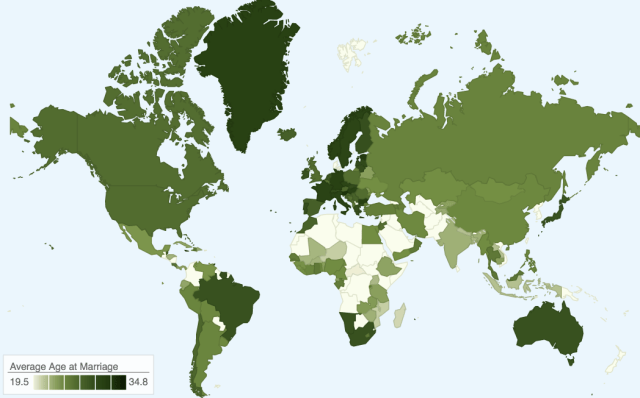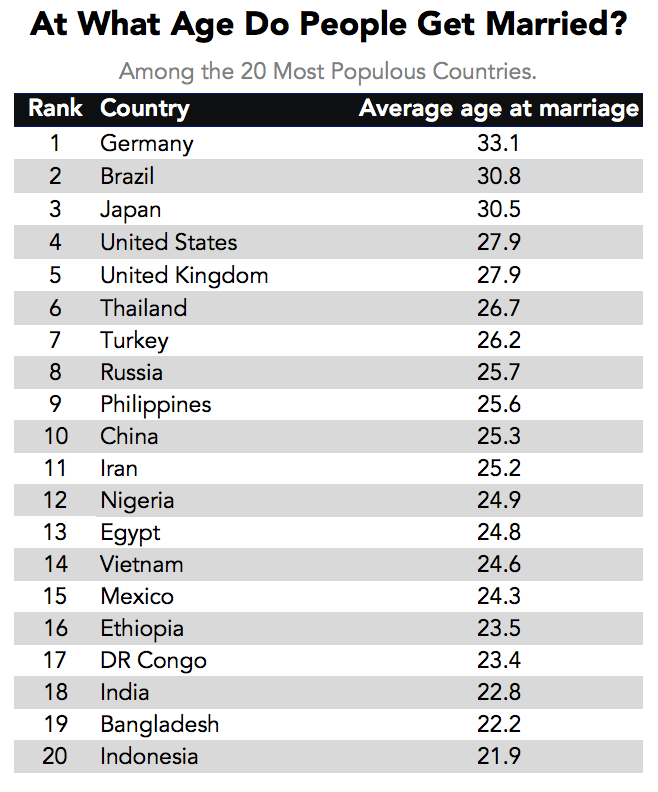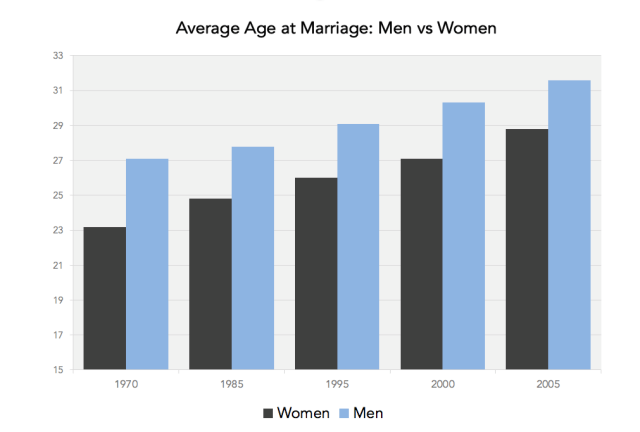
Map by Priceonomics; data from the United Nations World Marriage Data 2015
Every year, parents have more and more reason to ask their children when they plan to get married.
This is the case around the world, because marrying later than the previous generation is a global trend. People are getting married later—or not at all.
Yet this similarity co-exists with different marriage practices that can make people’s lives vary tremendously from country to country. In particular, which country you live in can impact how long you spend living single by as much as a decade.
You can see this discrepancy in the above map, which illustrates the average age at which people get married by country. It draws on data collected by the United Nations.
The contrast that immediately stands out is the connection between a country’s income and when its citizens marry. On average, people in wealthy, Nordic countries like Finland and Sweden do not marry until they are in their thirties. But in the Central African Republic, the average person marries before turning twenty—the lowest average in this data set.
The relationship between income levels and marriage, however, is not destiny: Although the United States is much richer than Chile, the average age at marriage in each country is around 28.
There are some limitations to this data. Since countries do not conduct surveys and censuses every year, this data does not represent the same time frame for every country. We only included countries whose latest data comes from 2009 to 2014, which is why much of central Africa has no data. The official metric calculated by these surveys, “Mean Singulate Age at Marriage”, also ignores people who never get married.
Yet the data still captures the fact that people enter marriage—a central institution for most of us—at different periods in their lives.

Chart by Priceonomics; data from the United Nations World Marriage Data 2015. Pakistan excluded due to a lack of recent data.
To make the above table and map, we averaged the age at which men and women get married in each country. But this hides an important dynamic: that men marry later than women. In this data set—which does not include a number of poorer countries—men in each country marry 3.7 years later than women.
This gender gap exists in every country. It is larger in poorer countries like Egypt, where women marry 5 years earlier than men. In richer countries like France, the gap is only 1.6 years.
This suggests that the gender gap may narrow as countries develop. This has occurred—as the below chart shows—but only gradually over the decades.

Chart from the United Nations World Marriage Data 2012; reformatted by Priceonomics
It remains common for women to marry very young in some countries. According to U.N. reports, 39 countries have data showing that 20% of women married by age 18. In twenty countries, a full 10% of women married by age 15. In only 2 countries, however, are 10% of men married before the age of 18.
Still, men and women are getting married later in every region of the world. The average age of marriage for women increased from 21.8 to 24.7 years from the seventies to the mid 2000s, with the average age for men rising a comparable amount.
This has resulted in some fairly dramatic stats here in the United States. Today, less than half of American adults are married—down from 72% in 1960—and almost as many babies are born out of wedlock as to married couples.
Nevertheless, around the world, the majority of people still get married, even if they get married later. In all but a dozen or so countries, 80% of men and women have been married by age 49, and even more people commit to similar relationships.
Despite different and changing practices around the world, shacking up is still the norm.
Our next article looks at the world’s greatest authors—as rated by the Internet. To get notified when we post it → join our email list.
![]()
Priceonomics published an earlier version of this article on November 22, 2013. It has been updated.
Note: If you’re a company that wants to work with Priceonomics to turn your data into great stories, learn more about the Priceonomics Data Studio.



